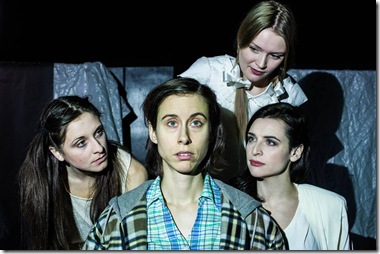Perfect Pie: disturbing drama which might have benefitted from a more thoughtful staging.
Photo: Andrew Alexander
Perfect Pie by Judith Thompson is the troubling portrait of a young woman Patsy trying to find herself after suffering the traumatic experience of a catastrophic train crash which involved her friend Marie and which changed both their lives dramatically. The play pieces together the memories of events leading up to the horrendous crash, by going back to their childhood, by following the evolution of their friendship. Flashbacks whizz by as memories of childhood are played out between the two young girls and as the two close friends meet in a more recent time frame, the past and the present converge at the height of that traumatic accident, after which Marie mysteriously disappeared. What happened really? What was the nature of their relationship? How is Patsy supposed to piece together all the strange events that seem to reveal multiple layers of a deeply ambiguous identity that evolve from the image of an epileptic childhood?
The staging of Perfect Pie presents multiple challenges for director Paul Griffin especially given the fact that this is not written as a case study of epilepsy although they make reference to it in the text. Epilepsy is of neurological origin, according to present day psychiatry, like Altzheimers or even Schizophrenia and has nothing to do with trauma, or psychological deviation of any kind.
Thompson’s interpretation of Marie, Patsy’s young school friend ,makes us believe that Marie is “different” and thus she is abused and picked on by the other children. The classmates use the excuse that Marie is poor and has problems which are identified with Epilepsy but none of that is very clear at the beginning. As a result her strange behaviour becomes a viscious circle, the result of cruel treatment she receives at the hands of her schoolmates as well as her parents which deeply traumatizes this young person. This later had a similar effect on Patsy, who witnessed the way her school chums destroyed the young girl’s life.and that illness is assumed by her friend soon after. It is clear that the train crash was a defining moment in their lives as the narrative shifts back and forth between the past, when the girls were young, and the present, when Patsy is married. At that point, Marie turns into Francesca who has a career as an actress and comes back to the old town where it all happened. Memories, suppressed experiences, present day images, pain and shock come swirling around until we come to suspect that the story unfolding before us is not as clear as it might seem. Whose wounded voice is bringing forth this past, and trying to insert it into the present? What is in fact happening?
A terribly disturbing play that uses generally accepted notions of Epilepsy on which to build the portraits. Even if the sequence of an epileptic fit comes over as a truthful representation of the real thing, it serves mainly as an excellent dramatic device to keep us glued to the story. That does not mean the causes of the illness were correctly explained. However, perhaps this does not matter because the play, is not a case study as I mentioned and the main problem about a young girls quest through the ambiguity of what is in fact her own identity, is best explained by these disturbing reactions exhibited by her relation with her young friend. Thompson could have also used the devices of multiple personality disorder which might have brought us even closer to a plausible explanation.
As it was , Sheena Turcotte as the country wife Patsy, and Gabbie Lazarovitz as Francesca / Marie who returned after finding a new life abroad, gave excellent performances as the mature friends. Megan Carty played the young Marie , tortured by her school chums and her performance was nuanced, thoughtful and outstanding. On the other hand, Erica Anderson as the young Patsy was a hysterical young thing, a caricature which was not the way to convince us that this young girl was actually very sympathetic towards her unhappy friend Marie. The set , lighting and sound design which involved images projected from the past were a bit heavy handed because the text was sufficiently clear to bring it all into focus. The fact this was originally written as a monologue is very clear. On the other hand, they might have made much better use of the shadows and the dramatic lighting to suggest shifts in consciousness, changes in mood, to remove us from everyday reality and transform the space into a place of inner drama , thus giving us more of an entry into what was really happening. The staging could have been a lot more expressive, or even even expressionistic!
This is nevertheless, a strong attempt to present this very difficult play that is certainly worth seeing. Perfect Pie continues at Arts Court Theatre until March 19, 2016.
A Production by Cart Before the Horse Theatre, and the Tactics group, under the artistic direction of Bronwyn Steinberg
Perfect Pie by Judith Thompson. Directed by Paul Griffin
Erica Anderson young Patsy
Megan Carty Marie
Gabbie Lazarovitz Francesca
Sheena Turcotte Patsy
Set design: Paul Griffin
Lighting design Zahra Larche
Sound and composition Martin Dawagne
Costumes and make-up Erica Anderson
Tactics Artistic direction Bronwyn Steinberg
